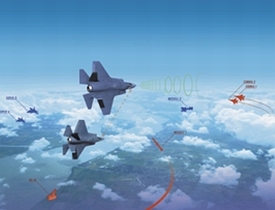 Embedded Combat Aircraft Training Systems (E-CATS), the innovative and cost effective system for tactical training of fighter pilots and the on-board provision for future LVC solutions
Embedded Combat Aircraft Training Systems (E-CATS), the innovative and cost effective system for tactical training of fighter pilots and the on-board provision for future LVC solutions
Today Lockheed Martin officially took delivery of the Embedded Training System for the F-35 Lightning II Joint Strike Fighter (JSF) which provides realistic and effective in-flight mission training for fighter pilots with the use of virtual entities. This software product is based on E-CATS (Embedded Combat Aircraft Training System) which is a joint development of Dutch Space and NLR.
Embedded Training
E-CATS is a training simulator system integrated with the operational systems of a fighter jet, enabling flexible scenarios for real-world exercises. E-CATS provides fighter pilots with in-flight training and simulated combat scenarios, including virtual air and ground adversaries. The computer-generated adversaries show up on the sensors of the F-35 like real hostile threats with realistic performance characteristics. Fighter pilots are able to train individually (single ship ET) or as a member of a team exercising a combat action in the multi-ship configuration of E-CATS.
Training with the E-CATS simulation programme makes it possible to perform the training anywhere, at any time, providing scenarios in limited air space and above sea, where it is nearly impossible to install ground threats.
Cost effective
As fewer aircraft are needed to serve as air adversaries (‘red airÂ), E-CATS will provide cost-reductions through savings on fuel, manpower and airframe life. In addition, E-CATS will facilitate more training content per flying hour and enable training missions to become more complex without adding cost. In short, it is estimated that millions of dollars could be saved annually. The need for less ‘red air flights’ during training missions will also reduce environmental impact.
E-CATS the cornerstone capability for LVC
Within the concept of Live, Virtual, Constructive (LVC) training now being explored by many air forces, the embedded E-CATS functionality in the F-35 provides a cornerstone capability. E-CATS provides the virtual threat environment as the constructive aspect of LVC. With E-CATS on-board, the fighter pilot can participate in mission training sessions within the confines of a LVC range, and also train anywhere, anytime, without the need of an instrumented training range.
Developing E-CATS
- Since the late 1990s, NLR and Dutch Space have cooperated in transforming Embedded Training for Combat Aircraft from concept to reality, and can now bring this technology to  the Joint Strike Fighter.
- Single-ship capability was demonstrated in 2004 on an operational Royal Netherlands Air Force F-16.
- In 2007, the multi-ship demonstration at Lockheed Martin provided further insight into the technical maturity and the additional advantages of multi-ship embedded training. Using multi-ship embedded training, fighter pilots can train in-flight within one shared virtual tactical environment. To implement this capability, each aircraft is fitted with a computer system with E-CATS software. E-CATS uses an existing data link to ensure each aircraft has the same common operational picture.
- Early 2009 Dutch Space and NLR received the contract from Lockheed Martin to implement the embedded training system E-CATS for the F-35.

